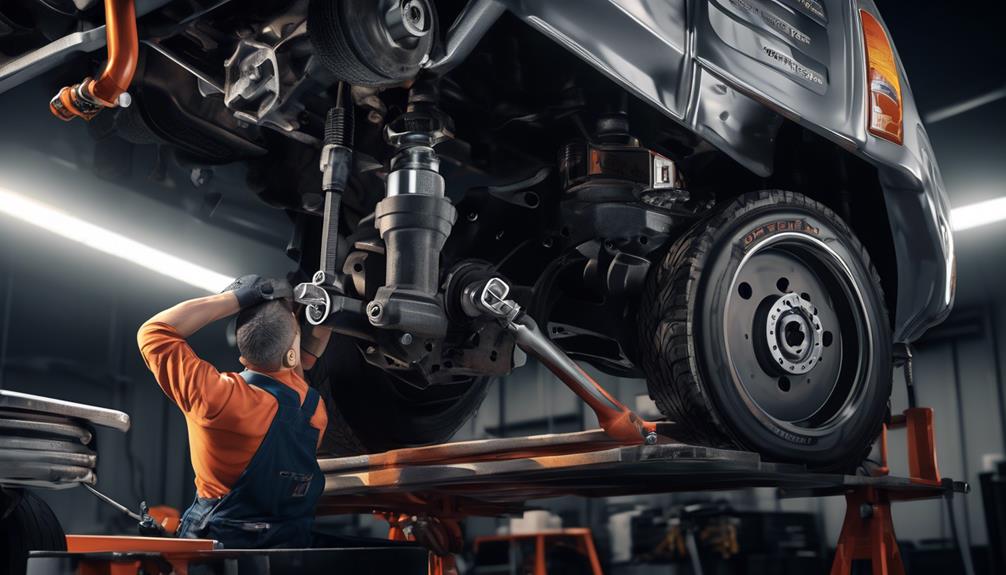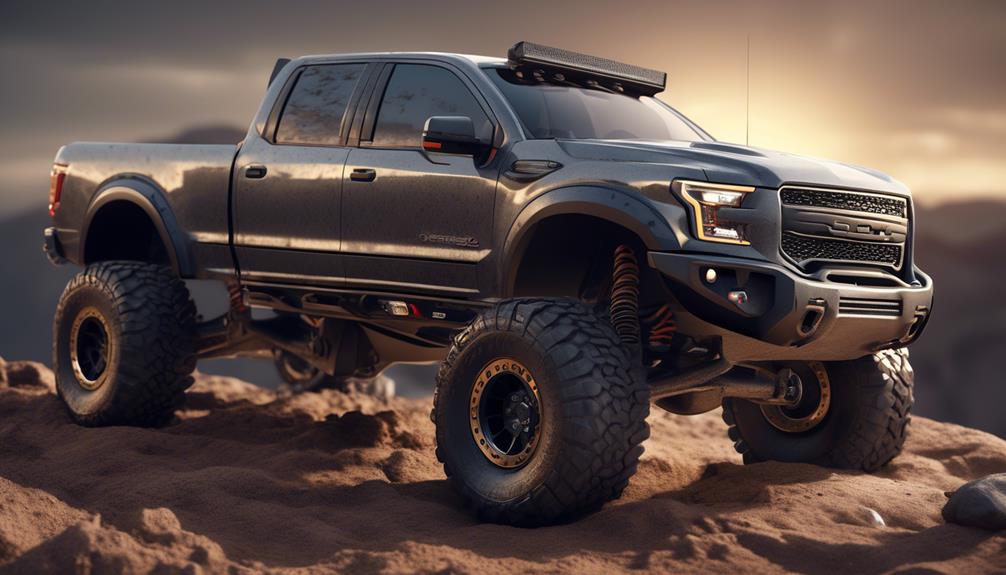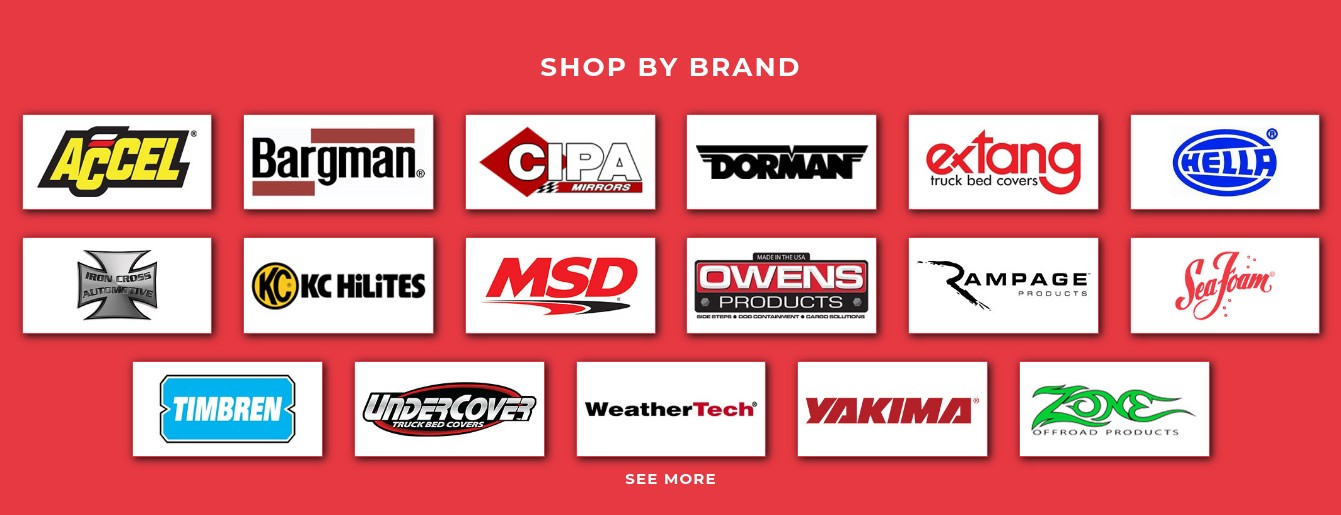So, you’ve been thinking about making some enhancements to your truck’s suspension system, eh? Well, you’re in luck because truck suspension upgrades can provide a significant boost to your vehicle’s performance and overall experience behind the wheel. From tackling rough terrains with ease to improving handling and stability, these upgrades have got you covered. But before we dive into the nitty-gritty details, there are a few things you need to know to ensure you make the right choices for your truck. Hang tight, because we’re about to unveil the world of truck suspension upgrades and all the benefits they bring.
Key Takeaways
- Suspension upgrades can significantly improve the ride quality of a truck, with options such as coilover kits, air suspension kits, lowering springs, sway bars, and strut braces.
- Upgrading the suspension can enhance a truck’s off-road capabilities, towing capacity, and overall performance.
- When choosing a suspension kit, it is important to consider the intended usage, budget, compatibility with existing components, and the reputation of the brand.
- Proper installation techniques, choosing the right components, and regular maintenance practices are crucial for optimal performance and safety.
Types of Suspension Upgrades
There are several types of suspension upgrades available for trucks, including coilover kits, air suspension kits, lowering springs, sway bars, and strut braces. These upgrades are designed to enhance the performance and control of your truck, allowing you to tackle any terrain with confidence.
Coilover kits are a popular choice for truck owners who want to improve their suspension. These kits consist of a coil spring and shock absorber, which work together to provide a smooth and controlled ride. With adjustable ride height and damping settings, coilover kits allow you to fine-tune your truck’s suspension to your liking.
Air suspension kits, on the other hand, use air-filled bags instead of traditional coil springs. This allows for a more comfortable and adjustable ride, as the air pressure can be adjusted to suit different driving conditions. Additionally, air suspension kits can provide extra ground clearance, making them ideal for off-road enthusiasts.
Lowering springs are a great option for truck owners who want to improve their truck’s handling and appearance. By lowering the ride height, these springs lower the truck’s center of gravity, resulting in improved cornering performance and reduced body roll.
Sway bars and strut braces are suspension upgrades that are designed to improve the stability and control of your truck. Sway bars reduce body roll during cornering, while strut braces provide additional support to the suspension components, resulting in improved handling and responsiveness.
Benefits of Upgrading Your Truck’s Suspension
Upgrading your truck’s suspension can provide several benefits. Firstly, it can greatly improve the ride quality by reducing vibrations and bumps, resulting in a smoother and more comfortable driving experience. Secondly, it can enhance the off-road capability of your truck, allowing it to tackle rough terrains with greater ease and stability. Lastly, upgrading the suspension can increase the towing capacity of your truck, making it capable of hauling heavier loads without compromising safety and performance.
Improved Ride Quality
Improving your truck’s suspension can greatly enhance the ride quality and performance of your vehicle. Upgrading your shocks is a key component in achieving a smoother ride. Here are four reasons why upgrading your truck’s suspension can lead to improved ride quality:
- Stiffer Shocks: Non-OEM shocks offer better control and stability, especially when carrying heavy loads or towing. These stiffer shocks effectively control saggy rear ends, providing a more balanced and level ride.
- Heavy-Duty Shocks: Trucks regularly carrying heavy loads require heavy-duty shocks. These shocks ensure better suspension performance and longevity, making them highly recommended for such applications.
- Avoid Compensatory Shocks: It’s important to avoid shocks meant to compensate for a lift if you’re not installing a lift kit. These shocks may adversely affect ride quality and stability.
- Aftermarket Upgrades: Consider upgrading your suspension with components like a solid steel tie rod, front wheel bearing, and sway bar end links. These upgrades can further enhance ride quality and control.
Enhanced Off-Road Capability
To enhance your truck’s off-road capability, upgrading your suspension can provide a range of benefits. One option is to install suspension kits, such as lift kits, control kits, or leveling kits, which can significantly improve your truck’s off-road performance. Lift kits offer additional ground clearance and allow for larger tires, while control kits enhance stability and control. Leveling kits help maintain levelness, crucial for optimal off-road performance. Upgrading your stock truck with aftermarket suspension components like steel upper control arms, lower ball joints, or bolt-in upper ball joints can further enhance off-road capability. Consider kits with Fox shocks, which offer superior damping and control. Additionally, upgrading to a wheel-bearing spindle or cast steel upper control can provide added durability for rugged off-road adventures. Quick shipping options are available for various suspension upgrades, ensuring prompt delivery for your off-road needs. Don’t let your stock suspension hold you back. Upgrade today and experience the freedom of enhanced off-road capability.
Increased Towing Capacity
If you’re looking to optimize your truck’s towing capacity, upgrading your suspension can provide a range of benefits that build upon the enhanced off-road capability discussed previously. Here are four key ways in which upgrading your truck’s suspension can increase its towing capacity:
- Improved Shock Absorption: Upgrading the shocks can improve overall suspension and provide better control over the saggy rear end, especially when carrying heavy loads.
- Helper Springs: Adding helper springs, such as leaf spring reinforcements or polyurethane braces, can prevent suspension squatting and reduce play in coil springs, ensuring stability and control while towing.
- Adjustable Torsion Bars: Adjustable torsion bars in the front end can change the ride height and keep the truck level, ensuring clearance and preventing the front end from sagging under heavy loads.
- Lift Kits: Installing a lift kit can provide increased ground clearance, allowing the truck to handle rough terrains while towing. However, it’s crucial to choose the right size to avoid sacrificing stability and reliability.
Factors to Consider When Choosing a Suspension Kit
When choosing a suspension kit for your truck, there are several factors you should consider. First, think about the intended usage of your vehicle. If you plan on doing a lot of off-road driving or heavy towing, you will need a suspension kit that is specifically designed for these purposes. Next, consider your budget. Suspension kits can vary greatly in price, so it’s important to evaluate the overall cost, including installation and any additional parts or adjustments that may be needed. Compatibility is another important factor to consider. Make sure the suspension kit you choose is compatible with your truck’s existing components and any future modifications you may want to make. It’s also crucial to select a reputable brand known for producing high-quality suspension kits. Research different brands and read reviews to ensure you’re getting a reliable product. Additionally, consider the complexity of installation. Some suspension kits may require professional installation, so factor in the associated costs. By taking all of these factors into account, you can choose the right suspension kit that meets your needs and provides the desired ride height, control, and comfort for your truck.
Installation Process for Truck Suspension Upgrades

When upgrading the suspension of your truck, the installation process is a crucial step to ensure proper functionality and performance. Here are four important steps to follow when installing truck suspension upgrades:
- Start by choosing the right suspension kit for your truck. Consider factors such as the desired lift height, control kits, and leveling options. Look for suspension kits and upgrades that are specifically designed for your make and model of truck.
- Before installing a lift kit, make sure to gather all the necessary tools and equipment. This may include a wheel bolt, jack stands, and a torque wrench. It is also important to read the instructions carefully and familiarize yourself with the installation process before getting started.
- Begin the installation process by lifting the truck and removing the old suspension components. This may involve removing the old shocks, springs, and control arms. Follow the instructions provided with your suspension kit for proper removal and installation procedures.
- Once the old components are removed, install the new suspension components according to the instructions. This may involve attaching new shocks, springs, and control arms. Make sure to tighten all bolts to the recommended torque specifications to ensure proper fit and functionality.
Common Mistakes to Avoid When Upgrading Your Truck’s Suspension
When upgrading your truck’s suspension, it is crucial to avoid common mistakes that can negatively impact performance and safety. Proper installation techniques should be followed to ensure the components are installed correctly and securely. Choosing the right components, such as shocks and helper springs, that are compatible with your truck’s suspension system is essential for optimal performance. Regular maintenance practices, including adjusting torsion bars and conducting thorough suspension tune-ups, should be prioritized to prevent handling and stability problems.
Proper Installation Techniques
To ensure a successful upgrade to your truck’s suspension, it is crucial to adhere to proper installation techniques, avoiding common mistakes that can negatively impact steering, tire wear, and overall performance.
Here are some important installation techniques to keep in mind:
- Follow proper alignment procedures: After upgrading your truck’s suspension, it is important to perform a wheel alignment to prevent steering issues and premature tire wear.
- Avoid over-tightening suspension components: Over-tightening can lead to premature wear and reduced performance. Follow the manufacturer’s torque specifications for each bolt.
- Check compatibility: Before installing an upgraded suspension kit, make sure it is compatible with your truck model. This will help avoid installation issues and potential safety concerns.
- Match shocks and springs: Mismatching shocks and springs can result in poor handling and reduced suspension effectiveness. Ensure that the shocks and springs are designed to work together for optimal performance.
Choosing the Right Components
Before upgrading your truck’s suspension, it is crucial to carefully choose the right components to avoid common mistakes that can compromise stability, ride quality, and overall performance. Consider existing components such as shocks and spring helpers to ensure compatibility and maximize the benefits of your upgrades. Pay attention to the intended use and load capacity of your truck to avoid sacrificing stability or ride quality with the wrong suspension components. Review the owner’s manual for proper adjustment procedures and seek professional alignment after adjusting torsion bars to ensure safety and optimal performance. When installing a lift kit, carefully assess the amount of clearance needed and the potential impact on stability and alignment, taking into account the truck’s existing suspension setup. Regularly inspect and maintain suspension components, including lubrication, alignment, and tire condition, to ensure long-term performance and safety.
Regular Maintenance Practices
After carefully choosing the right components for your truck’s suspension upgrades, it is essential to follow regular maintenance practices to avoid common pitfalls and ensure optimal performance and safety. Here are four important maintenance practices to keep in mind:
- Regularly inspect suspension components for wear and tear: Inspect your leveling kit, leaf springs, bolt pattern, ball joints, and rod ends for any signs of damage or excessive wear. Catching these issues early on can prevent major problems down the line.
- Avoid improper installation: Improperly installing suspension upgrades can lead to premature wear and potential safety hazards. Make sure to follow the manufacturer’s instructions and seek professional help if needed.
- Ensure proper lubrication: Properly lubricating bushings and joints is crucial for maintaining smooth operation and preventing squeaks. Use a high-quality lubricant recommended by the manufacturer.
- Perform regular wheel alignment and tire rotation: Regular wheel alignment and tire rotation can maximize the lifespan of your suspension components. It helps distribute weight evenly and prevents uneven tire wear.
Maintenance Tips for an Upgraded Truck Suspension
Regular maintenance is essential to ensure optimal performance and longevity of your upgraded truck suspension. When it comes to maintaining an upgraded truck suspension, there are a few important tips to keep in mind. Firstly, regularly inspect all components of your suspension, including the leveling kit, ball joints, and rod ends, to ensure they are in good condition. Look for any signs of wear or damage, such as loose or worn-out parts, and replace them as needed. Secondly, make sure to follow the manufacturer’s recommendations for lubrication and greasing of your suspension components. This will help reduce friction and ensure smooth operation. Additionally, pay attention to the bolt patterns and torque specifications when installing or replacing suspension components. Using the wrong bolt pattern or improper torque can lead to failures or premature wear. Lastly, if you have upgraded your truck suspension with a leveling kit, consider investing in a leveling kit with Bilstein shocks for enhanced performance and stability. These shocks are designed to provide improved damping and control, resulting in a smoother ride. By following these maintenance tips and taking care of your upgraded truck suspension, you can enjoy the benefits of improved performance and handling for years to come. And remember, when it comes to purchasing replacement parts or accessories for your upgraded suspension, choose a reputable supplier that offers quick shipping and reliable customer service.
Frequently Asked Questions About Truck Suspension Upgrades

If you’re considering upgrading your truck suspension, you may have some questions about the process and its benefits. Here are some frequently asked questions to help you understand more about truck suspension upgrades:
- What is the difference between a Leveling Kit With Bilstein and a Stage 1 Leveling Kit?
- A Leveling Kit With Bilstein is specifically designed to improve the overall suspension performance of your truck. It includes high-quality Bilstein shocks that provide better control and handling. On the other hand, a Stage 1 Leveling Kit focuses primarily on leveling the front of your truck with the rear to achieve a more balanced look.
- What is the difference between a Stage 1 Leveling Kit and a Stage 2 Leveling Kit?
- A Stage 1 Leveling Kit typically consists of front suspension components that level your truck by lifting the front end. On the other hand, a Stage 2 Leveling Kit includes additional components, such as rear lift blocks and extended shocks, to provide a more comprehensive suspension upgrade.
- What are the benefits of upgrading to an aftermarket Ball Joint With Aftermarket compared to a Ball Joint For Stock?
- An aftermarket Ball Joint With Aftermarket is designed with improved materials and construction to provide better durability and performance. It can handle increased loads and stress, making it ideal for trucks with suspension upgrades. On the other hand, a Ball Joint For Stock is designed to meet the OEM specifications and may not be able to handle the additional stress from upgraded suspension components.
- What are the advantages of using Steel Tie Rod Sleeves and a Spindle O-Ring with a Bearing Spindle Bolt Zinc?
- Steel Tie Rod Sleeves provide added strength and rigidity to the tie rod assembly, reducing the risk of bending or breaking under heavy loads. The Spindle O-Ring helps to keep contaminants out of the wheel bearing assembly, increasing its lifespan. Using a Bearing Spindle Bolt Zinc provides corrosion resistance, ensuring the longevity of the spindle bolt.
What are the benefits of upgrading truck suspension for off-road and urban driving in McAllen?
Upgrading your truck suspension can bring numerous benefits for off-road and urban driving in McAllen. With an upgraded suspension, you’ll experience improved stability, comfort, and control when tackling rugged terrains or navigating city streets. It enhances the truck’s off-road capabilities, allowing you to overcome obstacles and maintain better traction. Moreover, an upgraded suspension provides a smoother ride, reducing fatigue and enhancing overall driving experience. So, upgrade your truck suspension and enjoy the advantages it brings on both off-road and urban roads in McAllen.
Frequently Asked Questions
Can I Upgrade My Truck’s Suspension Myself, or Do I Need to Take It to a Professional?
You can definitely upgrade your truck’s suspension yourself. It’s a common DIY project that can solve common suspension problems, improve off-roading capabilities, and provide benefits like better handling, increased ground clearance, smoother ride, and improved load-carrying capacity. Just make sure you have the right tools and choose the right suspension upgrade for your needs.
What Is the Average Cost of Upgrading a Truck’s Suspension?
To upgrade your truck’s suspension, you have various options. These include modifications that offer benefits such as improved handling, increased ground clearance, smoother rides, better load distribution, enhanced stability, and towing and hauling performance. The cost of these upgrades varies.
How Long Does It Typically Take to Install a Suspension Upgrade on a Truck?
Installing a suspension upgrade on your truck typically takes 4-8 hours, depending on complexity and experience. Consult professionals or follow manufacturer instructions for accurate estimates. Get assistance for optimal performance and safety.
Are There Any Specific Brands or Manufacturers That Are Recommended for Truck Suspension Upgrades?
If you’re looking for the best truck suspension brands, consider KW Suspensions, Bilstein, H&R Springs, Eibach, and Tein. They offer performance suspension upgrades, off-road options, lift kits, lowering options, adjustable systems, air suspension upgrades, heavy-duty options, and upgrades for towing and hauling.
Will Upgrading My Truck’s Suspension Affect Its Towing or Hauling Capacity?
Upgrading your truck’s suspension can impact its towing or hauling capacity. Factors such as fuel efficiency, ride quality, compatibility with different truck models, proper alignment, off-road driving, heavy-duty towing, braking performance, durability, warranty implications, and professional installation should be considered.
Conclusion
In conclusion, upgrading your truck’s suspension system can greatly enhance its performance, handling, and ride quality. By replacing shocks, adding helper springs, adjusting torsion bars, or installing lift kits, you can optimize your truck’s ability to carry heavy loads and improve traction and stability on different terrains. When selecting suspension upgrades, consider factors like budget, intended use, compatibility, and maintenance. Remember, a well-upgraded suspension can be the key to unlocking your truck’s full potential and enjoying a smoother and more controlled ride.




0 Comments